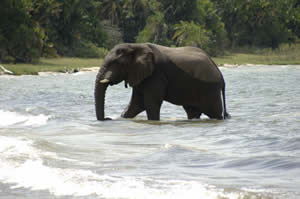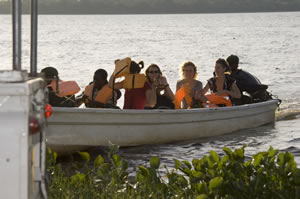 A pair of fish eagles guards the gentle bay, their distinctive black, white and chestnut feather pattern gleaming boldly in the morning sun. Suddenly, the birds toss back their heads in a piercing, evocative duet. On the sandbank below, a well-fed monster of a crocodile snaps to life, startled from its nap. It stampedes through the crunchy undergrowth, crashing into the water in front of the boat, invisible except for a pair of sentry-post eyes that peek menacingly above the surface to monitor our movements. Park size: 240 sq km (93 sq miles).
A pair of fish eagles guards the gentle bay, their distinctive black, white and chestnut feather pattern gleaming boldly in the morning sun. Suddenly, the birds toss back their heads in a piercing, evocative duet. On the sandbank below, a well-fed monster of a crocodile snaps to life, startled from its nap. It stampedes through the crunchy undergrowth, crashing into the water in front of the boat, invisible except for a pair of sentry-post eyes that peek menacingly above the surface to monitor our movements. Park size: 240 sq km (93 sq miles).
Rubondo Island is tucked in the southwest corner of Lake Victoria, the world’s second-largest lake, an inland sea sprawling between Tanzania, Uganda and Kenya. With nine smaller islands under its wing, Rubondo protects precious fish breeding grounds. Tasty tilapia form the staple diet of the yellow-spotted otters that frolic in the island’s rocky coves, while rapacious Nile perch, some weighing more than 100kg, tempt recreational game fishermen seeking world record catches.
 Rubondo is more than a water wonderland. Deserted sandy beaches nestle against a cloak of virgin forest, where dappled bushbuck move fleet yet silent through a maze of tamarinds, wild palms, and sycamore figs strung with a cage of trailing taproots. The shaggy-coated aquatic sitatunga, elsewhere the most elusive of antelopes, is remarkably easily observed, not only in the papyrus swamps it normally inhabits, but also in the forest interior.
Rubondo is more than a water wonderland. Deserted sandy beaches nestle against a cloak of virgin forest, where dappled bushbuck move fleet yet silent through a maze of tamarinds, wild palms, and sycamore figs strung with a cage of trailing taproots. The shaggy-coated aquatic sitatunga, elsewhere the most elusive of antelopes, is remarkably easily observed, not only in the papyrus swamps it normally inhabits, but also in the forest interior.
Birds are everywhere. Flocks of African grey parrots – released onto the island after they were confiscated from illegal exporters – screech in comic discord as they flap furiously between the trees. The azure brilliance of a malachite kingfisher perched low on the reeds competes with the glamorous, fl owing tail of a paradise flycatcher as it flits through the lakeshore forest. Herons, storks and spoonbills proliferate in the swampy lake fringes, supplemented by thousands of Eurasian migrants during the northern winter. Scents of wild jasmine, 40 different orchids and a smorgasbord of sweet, indefinable smells emanate from the forest.
Ninety percent of the park is humid forest; the remainder ranges from open grassland to lakeside papyrus beds. A number of indigenous mammal species – hippo, vervet monkey, genet and mongoose – share their protected habitat with introduced species such as chimpanzee, black-and-white colobus, elephant and giraffe, all of which benefit from Rubondo’s inaccessibility.

